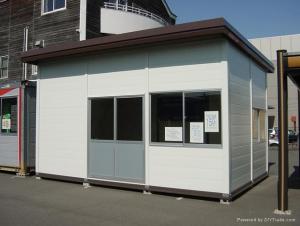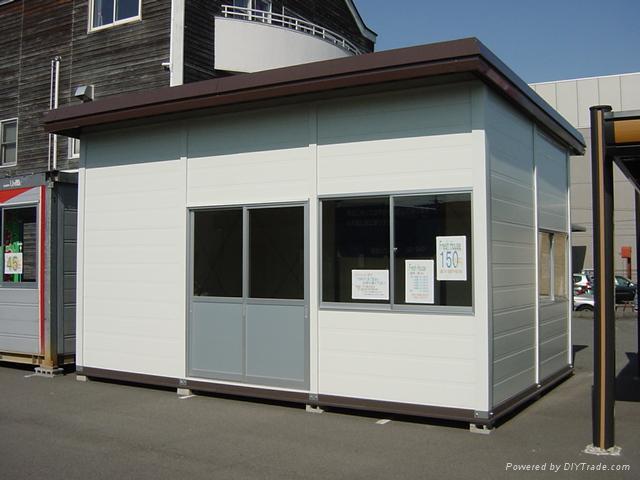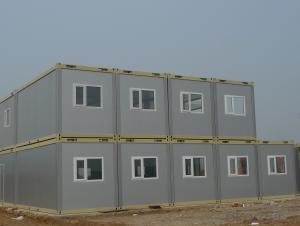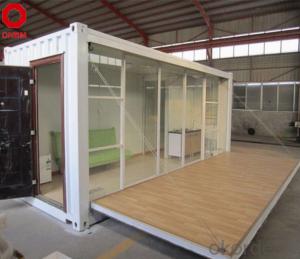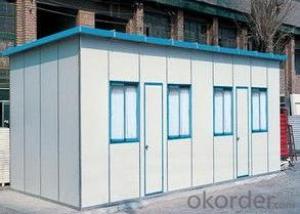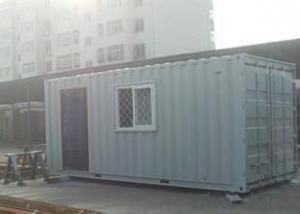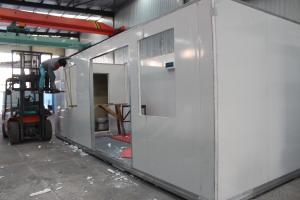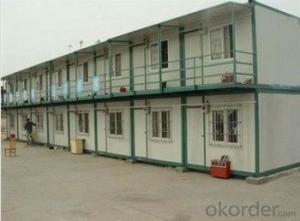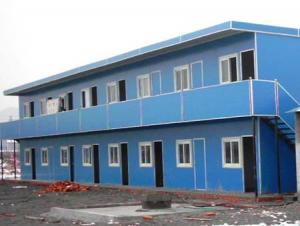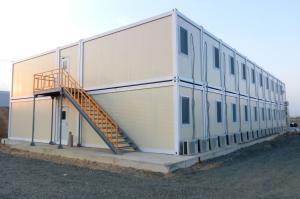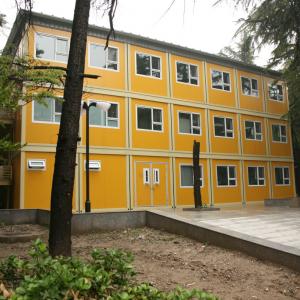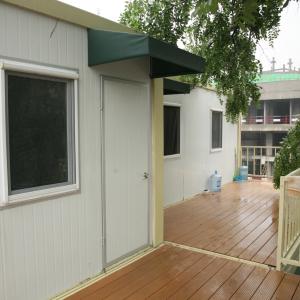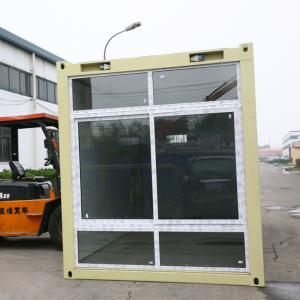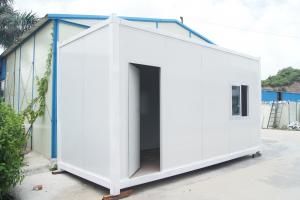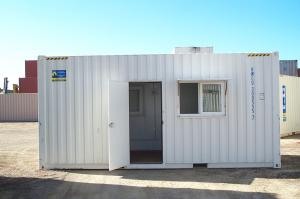Economical Container House
- Loading Port:
- China Main Port
- Payment Terms:
- TT OR LC
- Min Order Qty:
- -
- Supply Capability:
- -
OKorder Service Pledge
OKorder Financial Service
You Might Also Like
Container house
Container house is one kind of environmental architectural forms with high safety, high flexibility and strong adaptability. Compared with the traditional building of brick concrete structure, it can reduce 60% of concrete and water consumption during concrete construction, about 70% of construction waste and renovation waste, more than 40% of the construction period, about 50% of energy as well as noise pollution and dust pollution. However the price is 35% lower than traditional buildings. Its products are mainly applied to temporary housing on the construction site, room for mine field operation, room for emergency and all kinds of modern hotel building, mobile shops, private residential buildings
Due to the fine quality of steel in the main body, It can withstand the impact of sudden storm and torrential rain. In the meantime, it also can be combined together freely.
Each container house weighs about 8000 pounds, 40 feet long, with a bearing capacity of 50000 pound. Standard combined container houses can be stacked up to 8 stacks at most.
The functions of container houses tend to be diverse, for example, folding and pre-assembled container housing is a good solution to lack of space and huge cost in the process of transportation. In the meantime, it is also beneficial to field installation.
Container architecture also is simple in design, construction fast, material recycling, etc, in the future will be more and more widely used in the construction field。
- Q: Can container houses be designed for agricultural or farming purposes?
- Container houses have the ability to be designed for agricultural or farming purposes. Due to their versatility, container houses are well-suited for a variety of applications, including agriculture and farming. Farmers can customize and modify container houses to meet their specific needs, creating a comfortable and efficient space for various agricultural activities. Farm offices, storage facilities, and even living spaces for farmers and farmworkers can be provided by container houses. By incorporating proper insulation, ventilation, and electrical installations, container houses can create a suitable environment for storing agricultural equipment and supplies. Additionally, they can serve as temporary housing for seasonal workers or permanent residences for farmers. Container houses can be easily transported and assembled, allowing farmers to have flexible and portable structures on their agricultural land. This flexibility is particularly advantageous for farmers who need to relocate their operations or expand their farming activities to different locations. Furthermore, container houses can be equipped with hydroponic or aquaponic systems, enabling farmers to grow crops without soil or with minimal water usage. These systems can be seamlessly integrated into the design of container houses, resulting in an efficient and sustainable environment for cultivating crops. In conclusion, container houses present a cost-effective and adaptable solution for agricultural and farming purposes. They can be tailored to meet the specific requirements of farmers, providing a comfortable living or working space while facilitating sustainable farming practices.
- Q: Are container houses suitable for student housing?
- Yes, container houses can be suitable for student housing. They are affordable, eco-friendly, and can be easily customized to provide comfortable living spaces for students. Additionally, container houses can be quickly built and relocated, making them a flexible option for student housing in different locations.
- Q: Can container houses be designed to have a balcony?
- Container houses have the potential to include balconies in their designs. Many architects and designers have successfully integrated balconies into container house designs. There are various methods to add balconies to container houses, depending on the desired design and structural considerations. One common approach involves extending a section of the container to create a platform for a balcony. This can be achieved by cutting off a portion of the container and reinforcing it with additional steel beams or supports. Another option is to attach a pre-made balcony module to the container structure, creating a separate space that extends beyond the main container. Additionally, balconies can also be incorporated by stacking multiple containers in a way that creates open outdoor areas between them. By carefully planning and engineering, container houses can indeed include balconies, providing residents with the opportunity to enjoy outdoor spaces and make the most of the surrounding views.
- Q: Are container houses resistant to termites?
- Container houses are generally resistant to termites due to the materials they are made of. Most container houses are constructed using steel shipping containers, which are not susceptible to termite damage. Steel is an inorganic material that termites are unable to consume or damage. However, it is important to note that while the containers themselves may be termite-resistant, the foundation and other wooden elements used in the construction of a container house can still be vulnerable to termite infestations. It is crucial to ensure that proper termite prevention measures are taken during the construction of the foundation and any additional wooden components to maintain the overall termite resistance of the container house. Regular inspections and treatments by professionals can help to ensure that any potential termite issues are identified and addressed promptly.
- Q: Are container houses suitable for recreational or sports facilities?
- Yes, container houses can be suitable for recreational or sports facilities. Container houses can be easily modified and customized to create functional and versatile spaces for various recreational or sports activities. They are cost-effective, environmentally friendly, and can be easily transported and assembled in different locations. Additionally, container houses can be equipped with necessary amenities such as bathrooms, kitchens, and storage spaces, making them ideal for accommodating individuals or groups participating in recreational or sports activities.
- Q: Can container houses be designed with a communal laundry or utility room?
- Yes, container houses can be designed with a communal laundry or utility room. The layout and design of container houses are flexible, allowing for the inclusion of communal spaces such as laundry or utility rooms that can be shared by the residents. This shared facility can help optimize space utilization and provide convenience to the occupants.
- Q: Can container houses be built with a sustainable cooling system?
- Yes, container houses can be built with a sustainable cooling system. Various eco-friendly cooling options such as passive design strategies, natural ventilation, solar-powered air conditioning, and green roofing can be integrated into container houses to ensure a sustainable and energy-efficient cooling system. These solutions help minimize the environmental impact and reduce energy consumption while providing a comfortable living environment.
- Q: Can container houses be customized to fit individual preferences?
- Certainly, container houses can be customized to suit individual preferences without a doubt. The flexibility offered by constructing a home using shipping containers is one of its key advantages in terms of design and customization. Due to the modular nature of containers, they can be easily modified to cater to specific preferences, needs, and requirements. There are various ways in which container houses can be customized. Firstly, the interior layout can be tailored to fit individual preferences. Containers can be combined or stacked to create multiple levels or open spaces. Rooms or open-concept living areas can be created by adding or removing walls. Moreover, the placement of windows, doors, and other openings can be customized to maximize natural light and scenic views. Secondly, container houses can be customized in terms of aesthetics. The desired look can be achieved by painting or cladding the exterior of the containers with different materials. This allows for a wide range of design options, ranging from modern and minimalist to rustic and industrial. Furthermore, a personalized and unique living space can be created by using various finishes, colors, and materials for the interior. In addition, container houses offer flexibility when it comes to incorporating additional features and amenities. For example, individuals can choose to include solar panels for sustainable energy, incorporate a green roof for improved insulation and environmental benefits, or install smart home technology for convenience and efficiency. In summary, container houses present numerous opportunities for customization. They can be adapted to suit individual preferences in terms of layout, design, and additional features. Whether someone desires a contemporary, traditional, or unconventional style, container houses allow for the creation of a personalized living space that aligns with individual tastes and requirements.
- Q: Are container houses resistant to mold and mildew?
- Taking proper precautions during the construction process can ensure that container houses are resistant to mold and mildew. The use of steel in shipping containers makes them naturally resistant to mold and mildew. However, if the containers are not sealed or insulated adequately, moisture can enter the interior and promote the growth of mold and mildew. To prevent this, it is necessary to seal the containers properly, ensuring that all openings and gaps are sealed. Additionally, installing proper insulation and ventilation will help control moisture levels within the container. Regular maintenance, such as monitoring and addressing any signs of moisture or leaks, is also essential in preventing mold and mildew growth. In conclusion, by employing appropriate construction techniques and maintenance, container houses can effectively resist mold and mildew.
- Q: Can container houses be designed with off-grid wastewater treatment systems?
- Certainly, off-grid wastewater treatment systems can be incorporated into the design of container houses. These systems are specifically engineered to manage and treat sewage and wastewater in areas that lack a centralized sewer system. They employ a range of technologies, including septic tanks, composting toilets, and advanced treatment methods like constructed wetlands or anaerobic digesters. Due to their modular and portable nature, container houses are well-suited for accommodating off-grid wastewater treatment systems. The compact size of containers allows for the installation of septic tanks or composting toilets directly within the house. These systems effectively treat and process the waste produced within the container house, ensuring appropriate sanitation and wastewater disposal. Moreover, container houses can also be equipped with more advanced off-grid wastewater treatment systems. For instance, constructed wetlands can be established outside the container house to naturally treat wastewater using plants and soil. Anaerobic digesters can also be integrated to convert organic waste into biogas, which can then be utilized for cooking or heating. Overall, container houses offer immense design flexibility and can seamlessly integrate with off-grid wastewater treatment systems. This not only promotes sustainable living and self-sufficiency but also guarantees proper sanitation and environmental stewardship.
Send your message to us
Economical Container House
- Loading Port:
- China Main Port
- Payment Terms:
- TT OR LC
- Min Order Qty:
- -
- Supply Capability:
- -
OKorder Service Pledge
OKorder Financial Service
Similar products
Hot products
Hot Searches
Related keywords
